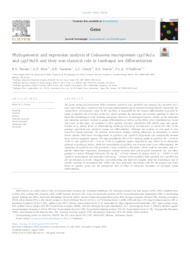Phylogenomic and expression analysis of Colossoma macropomum cyp19a1a and cyp19a1b and their non-classical role in tambaqui sex differentiation.
Phylogenomic and expression analysis of Colossoma macropomum cyp19a1a and cyp19a1b and their non-classical role in tambaqui sex differentiation.
Autoria: PAIXÃO, R. V.; SILVA, G. F. da; CAETANO, A. R.; CINTRA, L. C.; VARELA, E. S.; O'SULLIVAN, F. L. A.
Resumo: The genes coding for Cytochrome P450 aromatase (cyp19a1a and cyp19a1b) and estrogen (E2) receptors (esr1, esr2a and esr2b) play a conserved role in ovarian differentiation and development among teleosts. Classically, the "gonad form" of aromatase, coded by the cyp19a1a, is responsible for the ovarian differentiation in genetic females via ligation and activation of the Esr, which mediates the endocrine and exocrine signaling to allow or block the establishment of the feminine phenotype. However, in neotropical species, studies on the molecular and endocrine processes involved in gonad differentiation as well as on the effects of sex modulators are recent and scarce. In this study, we combined in silico analysis, real-time quantitative PCR (qPCR) assay and quantification of E2 plasma levels of differentiating tambaqui (Colossoma macropomum) to unveil the roles of the paralogs cypa19a1a and cyp19a1b during sex differentiation.
Ano de publicação: 2022
Tipo de publicação: Artigo de periódico
Unidade: Embrapa Amazônia Ocidental
Palavras-chave: Aromatase, Colossoma Macropomum, Cyp19a1, Neotropical fish, Promoter Structure, Sex development, Synteny, Tambaqui
Observações
1 - Por padrão são exibidas publicações dos últimos 20 anos. Para encontrar publicações mais antigas, configure o filtro ano de publicação, colocando o ano a partir do qual você deseja encontrar publicações. O filtro está na coluna da esquerda na busca acima.
2 - Para ler algumas publicações da Embrapa (apenas as que estão em formato ePub), é necessário ter, no celular ou computador, um desses softwares gratuitos. Sistemas Android: Google Play Livros; IOS: iBooks; Windows e Linux: software Calibre.
Acesse outras publicações
Acesse a Base de Dados da Pesquisa Agropecuária (BDPA) para consultar o acervo completo das bibliotecas da Embrapa.

